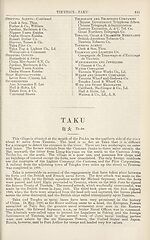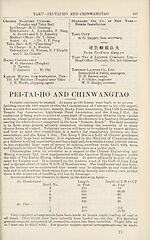1924
(716) Page 646
Download files
Complete book:
Individual page:
Thumbnail gallery: Grid view | List view

646
TAKU
During the week, June loth to 16th, the general situation in Chihli became critical
in the extreme, and it was a fine point to determine whether the Taku Forts command¬
ing the entrance of the Peiho should be seized. It will probably be a contentious ques¬
tion to the end of time if the ultimatum sent in by the Allied Admirals to the Command¬
er on Saturday, June 16th, to hand over'the Forts before next morning, precipitated the-
crisis in Tientsin and Peking or not. The official people in general held that it did;
lay observers affirm that it made no difference, that the Imperial Government now
captured by the Reactionaries was fully committed to the Boxer movement, and that
the non-capture of the Forts would have involved the destruction of every foreigner
and native Christian in North China. The admirals had to decide this fine
point, and, with the exception of the American officer, they took the line of men of
action. After a council of war they sent in the ultimatum that they would open fire at
daybreak next day if the Forts were not surrendered. Mr. Johnson, of the Taku Tug and
Lighter Company and a Chinese scholar, carrying his life in his hand, delivered the
ultimatum. His services were never recognized by the British Authorities. The
Commander referred the matter to Tientsin, and was ordered not only to resist but
to take the initiative. He did so by opening fire on the six gunboats lying in the Tong ku
reaches of the Peiho, about 2,000 yards in a bee-line above the forts (three miles by river)..
There is much general misapprehension about this brilliant feat of war. The allied Fleet
had nothing in the world to do with it, lying as it was 12 miles distant with a shallow
12-foot bar between it and the forts. The entire weight of the business fell on six
little cockle-shells of gunboats—the British Algerine, French Lion, German litis,
and the Russian Bohr,- Geleh and Korietz—and two landing parties of British and.
Japanese numbering about 300 each. The residents of Taku village found refuge in the-
U. S. Monocacy, which, after getting a shell through her bows, steamed up the river out.
of range. Many refugees fleeing from Tientsin were on the merchant steamers at the
wharves, and were under fire for some hours. The firing Was somewhat wild during,,
the darkness, but when dawn appeared, at 3.45, the gunboats, led at first by the Algerine'
and afterwards by the litis, steamed down the river and took up a position close under
the N.-W. Fort. A single well-timed shell would have utterly destroyed any one of the
six vessels, but Chinese gunnery was once more at fault. The naval guns soon
mastered the heavy and modern weapons on the Forts, and before 5 a.m. the two landing
parties had rushed the North-West Fort, and then proceeded along the causeway to the
large North Fort at the river mouth. This was also escaladed and its great guns turned
against the two fortifications on the South side of the river at close range. The whole
affair was finished before 6 a.m.—a large number of Chinese dead testifying to the-
accuracy of the Allies’ fire. Four Chinese torpedo-boat destroyers were captured with
conspicuous bravery by the British torpedo-boat destroyers Whiting and Fame anci
distributed amongst the Allies. The demolition of the Forts was effected during 1901 2.
Steamers drawing 18 feet have now no difficulty in crossing Taku Bar. An up-to-date
Tide Signal station was completed in 1921, using 8' symbols by day and electric light by
night, whereby depths in the Bar channel are recorded from 8 feet up to 19 feet, and
arrangements are being made in order to record depths up to 25 feet. A new suction
dredger and hopper, self-contained, is constantly employed on the Bar channel, which
is being widened. Although this channel is now much improved, a scheme is on foot to
make an entirely new one, in a more S.E. Easterly direction. The flood and the ebb
flow almost diagonally across the present channel. The Signal Station is under the
control of the Maritime Customs, but all tide poles and gauges are under the Hai Ho-
Conservancy.
DIRECTORY
fa £ itft ^ M
Ying-shang A-ei-a-huo-yu-kung-se
Asiatic Petroleum Co. (North China), |
Ltd.—Tongku Installation
^ Tdi-koo
Butterfield Swire (John Swire k
Sons, Ltd.), Merchants
H. H. Brown, agent
China Merchants’ Steam Navigation
Co.—Tongku
J. Johnson, lighter supt.
Chinese Government Railways—Tongku
(Peking-Mukden Line)
H. Farrant, district engineer
C. V. Engshom, locomotive inspector
TAKU
During the week, June loth to 16th, the general situation in Chihli became critical
in the extreme, and it was a fine point to determine whether the Taku Forts command¬
ing the entrance of the Peiho should be seized. It will probably be a contentious ques¬
tion to the end of time if the ultimatum sent in by the Allied Admirals to the Command¬
er on Saturday, June 16th, to hand over'the Forts before next morning, precipitated the-
crisis in Tientsin and Peking or not. The official people in general held that it did;
lay observers affirm that it made no difference, that the Imperial Government now
captured by the Reactionaries was fully committed to the Boxer movement, and that
the non-capture of the Forts would have involved the destruction of every foreigner
and native Christian in North China. The admirals had to decide this fine
point, and, with the exception of the American officer, they took the line of men of
action. After a council of war they sent in the ultimatum that they would open fire at
daybreak next day if the Forts were not surrendered. Mr. Johnson, of the Taku Tug and
Lighter Company and a Chinese scholar, carrying his life in his hand, delivered the
ultimatum. His services were never recognized by the British Authorities. The
Commander referred the matter to Tientsin, and was ordered not only to resist but
to take the initiative. He did so by opening fire on the six gunboats lying in the Tong ku
reaches of the Peiho, about 2,000 yards in a bee-line above the forts (three miles by river)..
There is much general misapprehension about this brilliant feat of war. The allied Fleet
had nothing in the world to do with it, lying as it was 12 miles distant with a shallow
12-foot bar between it and the forts. The entire weight of the business fell on six
little cockle-shells of gunboats—the British Algerine, French Lion, German litis,
and the Russian Bohr,- Geleh and Korietz—and two landing parties of British and.
Japanese numbering about 300 each. The residents of Taku village found refuge in the-
U. S. Monocacy, which, after getting a shell through her bows, steamed up the river out.
of range. Many refugees fleeing from Tientsin were on the merchant steamers at the
wharves, and were under fire for some hours. The firing Was somewhat wild during,,
the darkness, but when dawn appeared, at 3.45, the gunboats, led at first by the Algerine'
and afterwards by the litis, steamed down the river and took up a position close under
the N.-W. Fort. A single well-timed shell would have utterly destroyed any one of the
six vessels, but Chinese gunnery was once more at fault. The naval guns soon
mastered the heavy and modern weapons on the Forts, and before 5 a.m. the two landing
parties had rushed the North-West Fort, and then proceeded along the causeway to the
large North Fort at the river mouth. This was also escaladed and its great guns turned
against the two fortifications on the South side of the river at close range. The whole
affair was finished before 6 a.m.—a large number of Chinese dead testifying to the-
accuracy of the Allies’ fire. Four Chinese torpedo-boat destroyers were captured with
conspicuous bravery by the British torpedo-boat destroyers Whiting and Fame anci
distributed amongst the Allies. The demolition of the Forts was effected during 1901 2.
Steamers drawing 18 feet have now no difficulty in crossing Taku Bar. An up-to-date
Tide Signal station was completed in 1921, using 8' symbols by day and electric light by
night, whereby depths in the Bar channel are recorded from 8 feet up to 19 feet, and
arrangements are being made in order to record depths up to 25 feet. A new suction
dredger and hopper, self-contained, is constantly employed on the Bar channel, which
is being widened. Although this channel is now much improved, a scheme is on foot to
make an entirely new one, in a more S.E. Easterly direction. The flood and the ebb
flow almost diagonally across the present channel. The Signal Station is under the
control of the Maritime Customs, but all tide poles and gauges are under the Hai Ho-
Conservancy.
DIRECTORY
fa £ itft ^ M
Ying-shang A-ei-a-huo-yu-kung-se
Asiatic Petroleum Co. (North China), |
Ltd.—Tongku Installation
^ Tdi-koo
Butterfield Swire (John Swire k
Sons, Ltd.), Merchants
H. H. Brown, agent
China Merchants’ Steam Navigation
Co.—Tongku
J. Johnson, lighter supt.
Chinese Government Railways—Tongku
(Peking-Mukden Line)
H. Farrant, district engineer
C. V. Engshom, locomotive inspector
Set display mode to:
![]() Universal Viewer |
Universal Viewer | ![]() Mirador |
Large image | Transcription
Mirador |
Large image | Transcription
Images and transcriptions on this page, including medium image downloads, may be used under the Creative Commons Attribution 4.0 International Licence unless otherwise stated. ![]()
| Asian directories and chronicles > 1924 > (716) Page 646 |
|---|
| Permanent URL | https://digital.nls.uk/196433191 |
|---|
| Attribution and copyright: |
|
|---|---|
| Description | Volumes from the Asian 'Directory and Chronicle' series covering 1917-1941, but missing 1919 and 1923. Compiled annually from a multiplicity of local sources and research. They provide listings of each country's active corporations, foreign residents and government agencies of all nationalities for that year, together with their addresses. Content includes: various treaties; coverage of conflicts; currencies and taxes; consular fees; weights and measures; public holidays; festivals and traditions. A source of information for both Western states and communities of foreigners living in Asia. Published by Hongkong Daily Press. |
|---|---|
| Shelfmark | H3.86.1303 |
| Additional NLS resources: |

